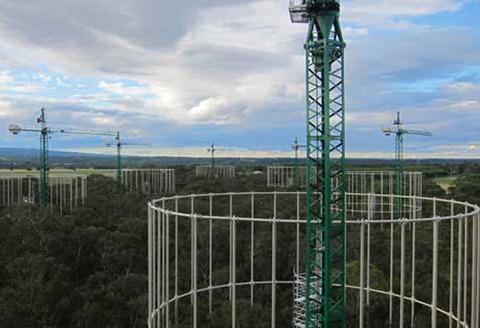当前位置:
X-MOL 学术
›
Funct. Ecol.
›
论文详情
Our official English website, www.x-mol.net, welcomes your
feedback! (Note: you will need to create a separate account there.)
Rainfall frequency and soil water availability regulate soil methane and nitrous oxide fluxes from a native forest exposed to elevated carbon dioxide
Functional Ecology ( IF 4.6 ) Pub Date : 2021-06-08 , DOI: 10.1111/1365-2435.13853 Catarina S. C. Martins 1 , Loïc Nazaries 1 , Manuel Delgado‐Baquerizo 2 , Catriona A. Macdonald 1 , Ian C. Anderson 1 , Brajesh K. Singh 1, 3
中文翻译:

降雨频率和土壤水分可用性调节来自暴露于二氧化碳升高的原生森林的土壤甲烷和一氧化二氮通量
更新日期:2021-08-09
Functional Ecology ( IF 4.6 ) Pub Date : 2021-06-08 , DOI: 10.1111/1365-2435.13853 Catarina S. C. Martins 1 , Loïc Nazaries 1 , Manuel Delgado‐Baquerizo 2 , Catriona A. Macdonald 1 , Ian C. Anderson 1 , Brajesh K. Singh 1, 3
Affiliation

|
- Free-air carbon dioxide enrichment (FACE) experiments in terrestrial ecosystems have demonstrated ecological responses of key ecosystem processes to rising atmospheric carbon dioxide (CO2). However, CO2 fertilization responses in field conditions have seldom included methane (CH4) and nitrous oxide (N2O), particularly in natural and mature forests, which are expected to have an important role in climate change mitigation.
- Herein, we aimed to capture the effect of elevated CO2 (eCO2; ambient vs. +150 ppm) on long-term temporal dynamics of CH4 and N2O fluxes, followed by identification of climo-edaphic factors explaining feedback responses. To achieve this, continuous monitoring of greenhouse gas (GHG) fluxes using a manual chamber technique, over a 3-year period was implemented in a mature dryland Eucalypt forest FACE (EucFACE) facility in Australia. The relationship between CH4 and N2O fluxes with rainfall indices and soil properties was also explored since they directly impact the microbial communities in the soil responsible for CH4 and N2O net emissions.
- Our results showed that in 3 years of eCO2 treatment, the amount and frequency of rainfall predicted GHG emissions in this native forest. We also found a significant reduction in CH4 sink (15%–25%) for some of the years as well as an overall treatment effect index reduction in N2O emissions under eCO2. Higher frequency of rain events with lower intensity led to highest CH4 sink followed by lowest N2O emissions due to fewer wet–dry cycles. Of all the environmental variables included, soil moisture, rainfall and pH were the main predictors of net CH4 and N2O emissions. Methane flux was also strongly influenced by soil texture.
- Our findings highlight the need to account for reduced forest CH4 sink under eCO2 in dryland ecosystems, which has implications for GHG budget predictions under future climate conditions.
中文翻译:

降雨频率和土壤水分可用性调节来自暴露于二氧化碳升高的原生森林的土壤甲烷和一氧化二氮通量
- 陆地生态系统中的自由空气二氧化碳富集 (FACE) 实验已经证明了关键生态系统过程对大气二氧化碳 (CO 2 )上升的生态响应。然而,田间条件下的CO 2施肥响应很少包括甲烷 (CH 4 ) 和一氧化二氮 (N 2 O),尤其是在天然和成熟森林中,预计它们将在减缓气候变化方面发挥重要作用。
- 在此,我们旨在捕捉升高的 CO 2(eCO 2;环境与 +150 ppm)对 CH 4和 N 2 O 通量的长期时间动态的影响,然后确定解释反馈响应的气候土壤因素。为实现这一目标,在澳大利亚成熟的旱地桉树林 FACE (EucFACE) 设施中,使用手动室技术连续监测温室气体 (GHG) 流量超过 3 年。还探讨了CH 4和 N 2 O 通量与降雨指数和土壤性质之间的关系,因为它们直接影响土壤中负责 CH 4和 N 2的微生物群落O 净排放。
- 我们的结果表明,在 3 年的 eCO 2处理中,降雨量和频率预测了这片原始森林的温室气体排放。我们还发现在某些年份CH 4汇显着减少(15%–25%),以及在 eCO 2下N 2 O 排放的整体处理效果指数减少。由于较少的干湿循环,较低强度的降雨事件频率较高导致最高的 CH 4汇,其次是最低的 N 2 O 排放。在包括的所有环境变量中,土壤湿度、降雨量和 pH 值是 CH 4和 N 2 O净排放量的主要预测因子。甲烷通量也受到土壤质地的强烈影响。
- 我们的研究结果强调需要考虑旱地生态系统中eCO 2下森林 CH 4汇的减少,这对未来气候条件下的温室气体预算预测有影响。










































 京公网安备 11010802027423号
京公网安备 11010802027423号